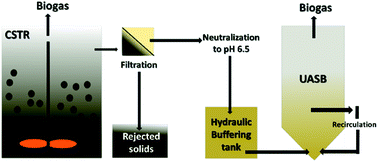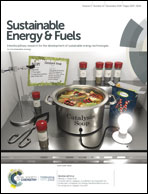Anaerobic digestion of synthetic food waste-cardboard mixtures in a semi-continuous two-stage system†
Abstract
A two-stage anaerobic digestion system consisting of a continuously-stirred tank reactor and upflow anaerobic sludge blanket (CSTR-UASB) in series was evaluated for semi-continuous digestion of food waste and corrugated cardboard mixtures. CSTR organic loading rates (OLRs) were 8 to 32 g chemical oxygen demand (COD) L−1 d−1 with varying mixture ratios. The CSTR VFA yield reached a maximum of 24% (COD basis) at 8 g COD L−1 d−1 and 65% food waste/35% corrugated cardboard. The UASB methane yield decreased from >90% (at CSTR OLRs of 8 to 16 g COD L−1 d−1 and all mixture ratios) to 75% (at 32 g COD L−1 d−1). The greatest methane production was achieved at a CSTR OLR of 16 g COD L−1 d−1 and 65% food waste/35% corrugated cardboard, and the UASB remained operable in all testing phases. While the CSTR-UASB system was able to accommodate changes in feed composition and OLR, both CSTR and UASB microbial communities diverged in response to these imposed changes. This study provides new insights about the simultaneous digestion of cardboard and food waste, major components of municipal solid waste.



 Please wait while we load your content...
Please wait while we load your content...
